Rolling its equipment onto a Tempe loading dock, Forge Devils Blacksmithing Club is reviving a practice from the past, forging both for practical use and as an artistic outlet.
In today’s society, the art of blacksmithing sits on the back-burner after the Industrial Revolution introduced cheaper and more efficient methods to make goods.
Jeffrey La Belle, assistant professor in the School of Biological and Health Systems Engineering, said technology made learning the trade less necessary.
“Blacksmithing is working and making art in metal,” La Belle said. “The Industrial Revolution destroyed a lot of it because a while ago, people wanted all their metal work to look perfect.”
With seven years of blacksmithing under his belt and a passion for the art, La Belle advises blacksmiths at ASU.
La Belle delved into a variety of different energy-efficient art forms including woodwork, but he said blacksmithing takes “reusable” to the next step.
“I’ve done woodworking before, and you take a piece of wood, remove wood and do something different to it, but then you’re pretty much at the end,” La Belle said. “Blacksmithing is really cool because you can take something and make something out of it and then make something else out of it.”
La Belle suggested creating Forge Devils last year while working with his mentor and designer of the ASU pitchfork, Poppa Dragon. The idea was to use the club as a way to teach techniques to ASU blacksmiths, while promoting creativity in the classroom.
While some are skilled and others beginners, members assist each other in the craft at their weekly meetings. As a way to teach the art and remain practical, the group plans to build their own tools to learn while expanding their inventory.
While the club meets out on the dock behind Noble Science Library, La Belle claims one can experiment with blacksmithing without heading into the lab.
“It’s not like the old days where people think a blacksmith has this huge room and there was a forge in it,” La Belle said. “You can pick up a propane forge and it’s pretty much the size of a microwave and you can take your blacksmithing anywhere you want to go.”
After watching videos on YouTube, electrical engineering junior Zach Burnham confidently made his first forge and obtained an anvil to use as an instrument to shape and hammer metal.
While blacksmithing may become a rarity, Burnham claims a need for it still stands.
“It is a way to expand your ability to think laterally and get a new perspective of engineering,” Burnham said. “We lose sight of the kind of work it took to create tools and equipment that people relied on.”
As president of Forge Devils, Burnham said he hopes to expand blacksmithing to a greater audience by involving the club with the art department next semester.
While some like Burnham use blacksmithing as a creative outlet, molecular biology junior Joseph Sidman likes it for its practical uses.
“I make tools, knives, swords and, recently, some tongs,” Sidman said. “The neat thing with blacksmithing is that if you don’t have tools, you can, for the most part, make them. It’s cool looking at how people actually created the tools and weapons before we had modern manufacturing.”
Sidman was fascinated by the old-fashioned technique and recognized the transition the U.S. has undergone.
“I liked the connection to the past," Sidman said. "I think it’s good to have an understanding of what life was like before. It gives you an appreciation for it. From an engineering background, blacksmiths were essentially the first engineers.”
Sidman advises those interested in blacksmithing to perfect one’s accuracy and remain persistent.
“You may think you have to be strong since you’re hammering for hours, but it’s more about knowing where to hit and being persistent enough,” Sidman said. “You can be as strong as you want but if you’re not hitting it in the right spot, it’ll take you a lot longer to shape the metal.”
Reach the reporter at ncorr@asu.edu or follow @natalieorr19 on Twitter.
Like The State Press on Facebook and follow @statepress on Twitter.




